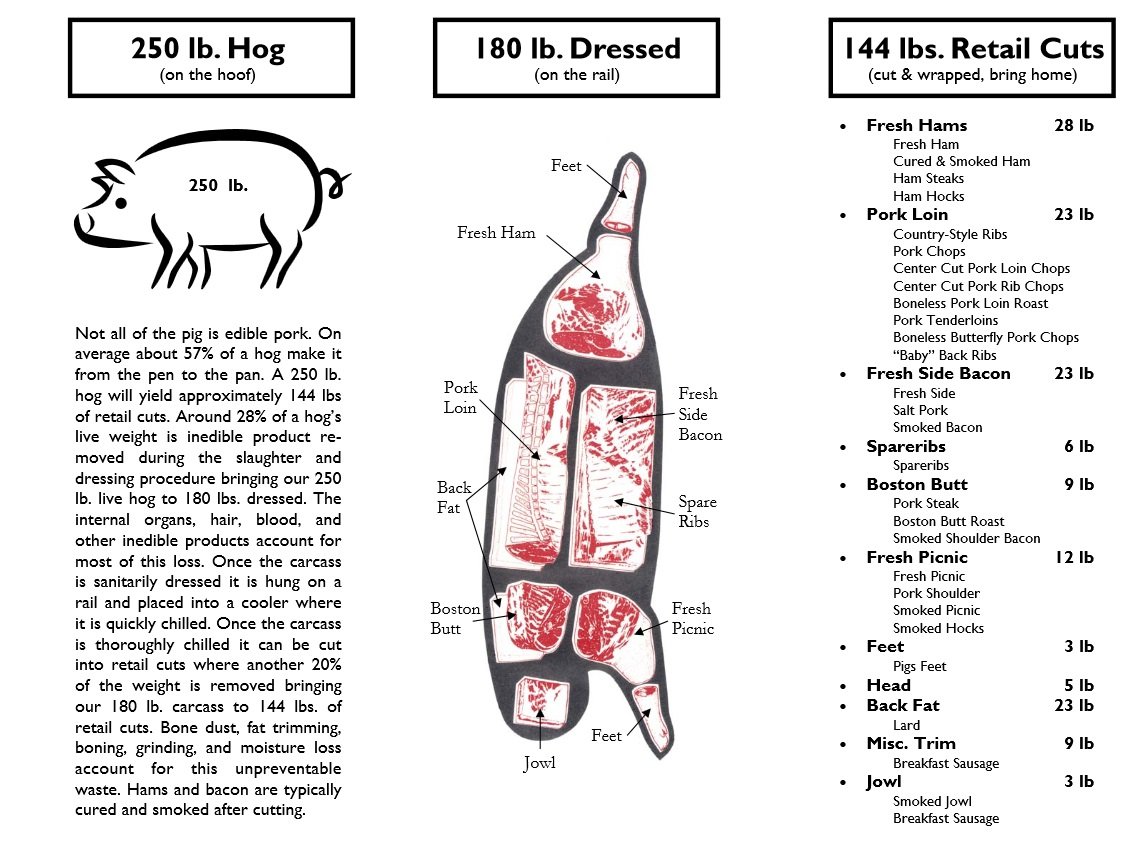The Short Answer
There are about 23 pork chops from a half pig, 2 roasts, 1 ham, 8 lbs of bacon slab, 3 lbs of spare ribs, 9 lbs of ground pork, totaling about 75 lbs in the freezer for half a pig in total.
The chart below gives you a quick graphic view. This can vary with the individual pig as well as how thick the pork chops are cut etc.
The Long Answer
As a pig gets larger there is more fat to trim off. A typical harvest weight is between 250-300 pounds.
A 250lb pig will yield on average about 180 lbs of hanging weight (meaning head, feet, and entrails removed.) If you just take the prime cuts you will get about 120lbs of meat in the freezer. If you take the whole pig home - nose to tail - you will get about 160 lbs of meat in the freezer. Nose to tail includes hocks, soup bones, lard, liver, jowls (like bacon), head, trotters (feet), and other bits. If you do your research upfront, you will see that you can use the blood and just about every other part of the pig to make something delicious and highly edible out of.
The joy of having a big ole piece of meat in your hands is that you can have it cut up any way you like! If you take a look at the chart below you can see another sample of different cuts available from the butcher.
No matter what cuts you ask for, you will have to decide how much sausage you want. This is sausage in bags of around a pound each - not links. Links always cost a little bit more. Bulk sausage can be used for meatballs, chilli, American chop suey, spaghetti sauce, breakfast sausage patties with fresh pastured chicken eggs, etc. Our butcher offers several flavors such as plain, sweet Italian, mild Italian, hot Italian, or maple. For a standard cut there is only about nine pounds of sausage so it is best to stick to one type of seasoning.
A typical pig will yield 60 to 70 pounds of cuts (which is roughly 57% of the live weight). Since our pigs are pasture-raised animals, they have some variance rather than the cookie-cutter uniformity of factory-farmed, GMO products.
Two other terms around pig weight that you might have is hanging weight and live weight.
HANGING WEIGHT
The hanging weight is the combination of both the left and right side of the pig. This is usually measured without the skin, the head, or the feet. Some places measure the hanging weight with the head, skin, and feet which yields a higher hanging weight. Without the extra parts you lose some meat, pork rinds, etc. But with all the extra parts your hanging weight is higher.
The processing is a notable part of the cost of a pig. If you process the pig yourself, the butchering or both the butchering and the slaughtering, you save yourself a lot of money. It's not too hard to do but it takes time, skill, tools and the space and willingness to do so.
LIVE WEIGHT
The live weight concept is buying a whole, live, breathing, snorting, pig and is usually a number which is only used by the farmer in determining when a hog is ready for harvesting.

